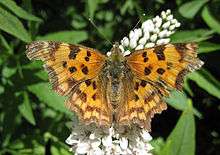Definify.com
Webster 1913 Edition
Comma
Com′ma
,Noun.
[L.
comma
part of a sentence, comma, Gr. [GREEK] clause, fr. [GREEK] to cut off. Cf. Capon
.] 1.
A character or point [,] marking the smallest divisions of a sentence, written or printed.
2.
(Mus.)
A small interval (the difference between a major and minor half step), seldom used except by tuners.
Comma bacillus
(Physiol.)
, a variety of bacillus shaped like a comma, found in the intestines of patients suffering from cholera. It is considered by some as having a special relation to the disease; – called also
– cholera bacillus
. Comma butterfly
(Zool.)
, an American butterfly (
Grapta comma
), having a white comma-shaped marking on the under side of the wings.Webster 1828 Edition
Comma
COMMA
, n.1.
In writing and printing, this point [,] denoting the shortest pause in reading, and separating a sentence into divisions or members, according to the construction. Thus, There is not a just man upon earth, that doeth good, and sinneth not. Virtue, wit, knowledge, are excellent accomplishments. Live soberly, righteously, and piously, in the present world.2.
In music, an enharmonic interval, being the eighth part of a tone, or the difference between a major and a minor semitone; a term used in theoretic music to show the exact proportions between concords.3.
Distinction.Definition 2025
comma
comma
English

a comma butterfly
Alternative forms
- (obsolete): come
Noun
comma (plural commas or commata)
- (typography) The punctuation mark ⟨,⟩ used to indicate a set off parts of a sentence or between elements of a list.
- 1828, Richard Thomson, Illustrations of the History of Great Britain, Vol. II, pp. 145–6:
- No points were used by the ancient printers, excepting the colon and the period; but, after some time, a short oblique stroke, called a virgil, was introduced, which answered to the modern comma. In the fifteenth century this punctuation was improved by the famous Aldus Manutius with the typographical art in general; when he gave a better shape to the comma, added the semicolon, and assigned to the former points more proper places.
- 1828, Richard Thomson, Illustrations of the History of Great Britain, Vol. II, pp. 145–6:
- (Romanian typography) A similar-looking subscript diacritical mark.
- A European and North American butterfly, Polygonia c-album, of the family Nymphalidae.
- (music) a difference in the calculation of nearly identical intervals by different ways.
- (genetics) A delimiting marker between items in a genetic sequence.
- In Ancient Greek rhetoric a comma (κόμμα) is a short clause, something less than a colon, originally denoted by comma marks. In antiquity comma was defined as a combination of words that has no more than eight syllables. This term is later applied to longer phrases, e.g. the Johannine comma.
Synonyms
- (English typography): scratch comma, virgule, virgil, virgula (in its obsolete form as a slash); come (in its obsolete form as a middot); comma-point (obsolete)
Hyponyms
- (punctuation mark): See serial comma
Derived terms
Translations
punctuation mark ','
|
|
butterfly
|
|
Derived terms
punctuation mark
See also
|
|
|
Latin
Etymology
From the Ancient Greek κόμμα (kómma), from κόπτω (kóptō, “I cut”).
Pronunciation
- (Classical) IPA(key): /ˈkom.ma/, [ˈkɔm.ma]
Noun
comma n (genitive commatis); third declension
Declension
Third declension neuter.
| Case | Singular | Plural |
|---|---|---|
| nominative | comma | commata |
| genitive | commatis | commatum |
| dative | commatī | commatibus |
| accusative | comma | commata |
| ablative | commate | commatibus |
| vocative | comma | commata |
Usage notes
- In the works of Cicero and Quintilian, the untransliterated Greek κόμμα (kómma) is used for comma in the grammatical sense of “a division…of a period smaller than a colon”.
Synonyms
References
- comma in Charlton T. Lewis and Charles Short (1879) A Latin Dictionary, Oxford: Clarendon Press
- COMMA in Charles du Fresne du Cange’s Glossarium Mediæ et Infimæ Latinitatis (augmented edition, 1883–1887)
- Félix Gaffiot (1934), “comma”, in Dictionnaire Illustré Latin-Français, Paris: Hachette, page 348/3.